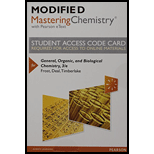
Concept explainers
a.
To determine:
If the given reaction involves condensation, hydrolysis, oxidation or reduction.
Introduction:
Atoms consist of three subatomic particles namely proton, electron, and neutron. Out of these subatomic particles only electrons are involved in bonding. The formation of a bond between two species is always due to the involvement of electrons either it undergoes loss of electrons or gains of electrons.
b.
To determine:
If the given organic reaction involves condensation, hydrolysis, oxidation or reduction.
Introduction:
Atoms consist of three subatomic particles namely proton, electron, and neutron. Out of these subatomic particles only electrons are involved in bonding. The formation of a bond between two species is always due to the involvement of electrons either it undergoes loss of electrons or gains of electrons.
Want to see the full answer?
Check out a sample textbook solution
Chapter 5 Solutions
Modified Mastering Chemistry with Pearson eText -- Standalone Access Card -- for General, Organic, and Biological Chemistry (3rd Edition)
- Glucose is a reducing sugar, which if boiled in Benedicts reagent produces an orange to brick-red color. What chemical species is being reduced during the reaction?arrow_forwardSome metals, such as iron, can be oxidized to more than one oxidation state. Obtain the balanced net ionic equations for the following oxidation reduction reactions, in which nitric acid is reduced to nitric oxide, NO. a Oxidation of iron metal to iron(II) ion by nitric acid. b Oxidation of iron(II) ion to iron(III) ion by nitric acid. c Oxidation of iron metal to iron(III) by nitric acid. [Consider adding the a and b equations.]arrow_forwardIndicate whether each of the following substances loses or gains electrons in a redox reaction. a. The oxidizing agent b. The reducing agent c. The substance undergoing oxidation d. The substance undergoing reductionarrow_forward
- What evidence of chemical change is visible when electricity passes through water ? How are the products of electolysis are different from the reactnt H2O?arrow_forwardMicroorganisms can break down organic matter using a wide variety of oxidants (electron acceptors). Use a half reaction or other approach to write balanced reactions for the oxidation of sucrose (C12H22O11) to CO2 in combination with each of the following electron acceptors: (d) sulfate (reduced to hydrogen sulfide, H2S ); and (e) carbon dioxide (reduced to methane, CH4) Thank youarrow_forwardAt 900 °C, titanium tetrachloride vapor reacts with molten magnesium metal to form solid titanium metal and molten magnesium chloride.Which substance is the reductant, and which is the oxidant?arrow_forward
- Identify the reactant that gets oxidized in the following reaction. 2 AgNO₃(aq) + CaI₂(aq) → 2 AgI(s) + Ca(NO₃)₂(aq)arrow_forwardWhat type of reaction is involved in the following: AgSCN + FeCl3arrow_forwardMicroorganisms can break down organic matter using a wide variety of oxidants (electron acceptors). Use a half reaction or other approach to write balanced reactions for the oxidation of sucrose (C12H22O11) to CO2 in combination with each of the following electron acceptors: (a) oxygen; (b) nitrate (reduced to N2); (c) iron III (reduced to iron II); (d) sulfate (reduced to hydrogen sulfide, H2S ); and (e) carbon dioxide (reduced to methane, CH4) Thank youarrow_forward
- At the end of a redox reaction, the electron carrier is (reductin or oxidized) , while the oxidized molecule( loss electrons or gain electrons.)arrow_forwardO2 + 2H+ + Fe --> Fe2+ + H2O In the reaction, the reactant being reduced is?arrow_forwardAn electrolytic cell converts: A) Chemical energy into electrical energy B) Chemical energy into mechanical energy C) Mechanical energy into electrical energy D) Electrical energy into chemical energyarrow_forward
 General, Organic, and Biological ChemistryChemistryISBN:9781285853918Author:H. Stephen StokerPublisher:Cengage Learning
General, Organic, and Biological ChemistryChemistryISBN:9781285853918Author:H. Stephen StokerPublisher:Cengage Learning Chemistry for Engineering StudentsChemistryISBN:9781337398909Author:Lawrence S. Brown, Tom HolmePublisher:Cengage LearningChemistry: Matter and ChangeChemistryISBN:9780078746376Author:Dinah Zike, Laurel Dingrando, Nicholas Hainen, Cheryl WistromPublisher:Glencoe/McGraw-Hill School Pub Co
Chemistry for Engineering StudentsChemistryISBN:9781337398909Author:Lawrence S. Brown, Tom HolmePublisher:Cengage LearningChemistry: Matter and ChangeChemistryISBN:9780078746376Author:Dinah Zike, Laurel Dingrando, Nicholas Hainen, Cheryl WistromPublisher:Glencoe/McGraw-Hill School Pub Co Chemistry for Today: General, Organic, and Bioche...ChemistryISBN:9781305960060Author:Spencer L. Seager, Michael R. Slabaugh, Maren S. HansenPublisher:Cengage Learning
Chemistry for Today: General, Organic, and Bioche...ChemistryISBN:9781305960060Author:Spencer L. Seager, Michael R. Slabaugh, Maren S. HansenPublisher:Cengage Learning General Chemistry - Standalone book (MindTap Cour...ChemistryISBN:9781305580343Author:Steven D. Gammon, Ebbing, Darrell Ebbing, Steven D., Darrell; Gammon, Darrell Ebbing; Steven D. Gammon, Darrell D.; Gammon, Ebbing; Steven D. Gammon; DarrellPublisher:Cengage Learning
General Chemistry - Standalone book (MindTap Cour...ChemistryISBN:9781305580343Author:Steven D. Gammon, Ebbing, Darrell Ebbing, Steven D., Darrell; Gammon, Darrell Ebbing; Steven D. Gammon, Darrell D.; Gammon, Ebbing; Steven D. Gammon; DarrellPublisher:Cengage Learning Chemistry & Chemical ReactivityChemistryISBN:9781337399074Author:John C. Kotz, Paul M. Treichel, John Townsend, David TreichelPublisher:Cengage Learning
Chemistry & Chemical ReactivityChemistryISBN:9781337399074Author:John C. Kotz, Paul M. Treichel, John Townsend, David TreichelPublisher:Cengage Learning





